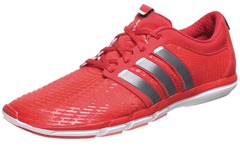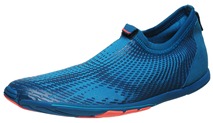(Note – this post was edited from its original form at the request of adidas)
I’ve been hearing a lot of hushed rumors lately that adidas is up to something. Apparently they have a new cushioning material that they are calling BOOST that is composed of thermoplastic beads that are fused together to form the midsole of a shoe. These rumors were confirmed this afternoon when I opened the March issue of Runner’s World Magazine and saw a review of the adidas Energy Boost running shoe on pg. 92 (the sole looks very much like a wedge of Styrofoam; in unrelated news, I wrote a short piece on running shoes and injuries on pg. 68 of the same issue of RW).
RW describes the shoe as having a “bouncy” feel, and reports that it topped 800 other shoes that they have tested for energy return after impact. RW also writes that BOOST is less sensitive to fluctuations in temperature, which means the midsole won’t feel as hard as a brick when running in sub-freezing temperatures (something I have experienced often this winter).
Time will tell if BOOST is just another gimmick or a truly revolutionary innovation. If they do live up to the hype, it will be interesting to watch the debate at the competitive elite level regarding a potential performance advantage provided by the shoes.
adidas released a promo video today of a ball drop test showing the energy return of BOOST relative to traditional EVA foam. For now that’s all I have – I’ll add more details as I get them.
My buddy Thomas over at Believe in the Run shared some of his thoughts on the adidas Energy Boost as well.




















I’ll stick with flubber….
Will my foot come back up and hit me upside the head?
don’t know if that’s necessarily a good thing, looks like it will make the leg do even less…just from a normal non-scientist perspective, i’m just digging my feet and concrete :D…or dirt….or other surfaces
How was this post edited from its original form?
Adidas asked me to take the whole thing down, apparently there is an embargo on posting about the shoe till Feb. 13 (not something I had ever agreed to or was even informed of). I agreed to remove a photo that was leaked, but in my opinion once it’s in Runner’s World the cat is out of the bag.
Sent from my iPad
Yeah, that’s pretty silly.
Years ago, NB promoted the opposite. With a similar ball drop demo, the ball bounced back the least and apparently that was good thing. I hate these kinds of marketing gimmicks. We’re not metal marbels dropping onto cement so why does this have any relevance.
“We’re not metal marbles dropping onto cement so why does this have any relevance.”
Exactly. Our legs have their own elastic properties, which this will no doubt interfere with. I’d like to see that test repeated using a superball. I’d wager the superball would bounce less coming off Adidas’ new plastic than it would off the concrete…
That to me would better represent how these might alter running dynamics…
This sounds like a question that Gordo and Luis should have some opinions on…
—-
Pete Larson’s Web Links:
-My book: Tread Lightly: link to ow.ly
-Blog: https://runblogger.com
-Twitter: link to twitter.com
-Facebook Page: link to facebook.com…
-Discussion Forum: https://runblogger.com/forum
The farther my distances are getting, the more I’ve been appreciating adequate cushioning. If this can increase cushioning while decreasing thickness possibly, I’m all for it!
A couple of the adidas sponsored athletes were wearing the Adios Boost this morning, due out in October, I think. Lower profile, like the Hagio, but with the Boost midsole, which is pretty obvious when you see it. It looks almost unfinished, but kinda cool. “Bouncy” was used to describe it, which I’d heard before.
adidas has always been good at making shoes that feel fast and responsive; that is where they are the best. I suspect that Boost will be the same kind of thing.
Now if they would just drop the Adistar line.
I wonder if they’ll be bouncier than Z-coils?
Sent from my iPad
I’m not an expert, but it seems to me that, in order to be effective, the bounce time should be the same time as your feet are touching the ground. Compare it with a trampoline: if you jump on one and you want to jump faster than the trampoline is bouncing back, you won’t have any benefit from it. This means for the shoe that in order to get a benefit form the bounce, you’ll have to adjust your stride to the shoes characteristics. I guess this is true for every shoe on the market, and it defines whether a shoe feels responsive or not.
I agree – I think the benefit will be very much individually based if there is any. It would also seem to me to be of limited benefit to have energy returning material under the heel since propulsion comes when the heel is already off the ground.
—-
Pete Larson’s Web Links:
-My book: Tread Lightly: link to ow.ly
-Blog: https://runblogger.com
-Twitter: link to twitter.com
-Facebook Page: link to facebook.com…
-Discussion Forum: https://runblogger.com/forum
Propulsion horizontally is provided entirely by the runner, any horizontal shearing in the sole on landing will absorbed and when loading is reduce oppose forward motion. So for propulsion sake you want perfectly rigid sole.
However, horizontal propulsion forces are far smaller and less important to a runner than size of the vertical forces that the runner has to generate on stance. Here a sole that provides greater energy return can indeed help, it’ll even help with pushing the heel off the ground – just a tiny tiny bit :-)
The amount of energy absorbed by the sole is an integral of the force over distance of compression, the amount returned is then dependent upon properties of the material. The amount of energy return is always than put in, so it’s really a game of how much energy the sole absorbs through the whole cycle.
If this sole is more efficient then it’ll be in reducing the vertical energy absorbed by the sole.
Thanks Robert for the engineering perspective as always! A problem with the video is that the human body is not a steel ball as pointed out elsewhere in the comments, and the human body is remarkably good at adjusting in small ways to anything underfoot (changing muscle activation, limb stiffness, etc.). It’s why mechanical testing of shoes can’t always tell you how the shoe will behave when on the human foot. Seems to me that for adidas to claim that this shoe provides any performance advantage they’d have to take two weight and dimension matched shoes, one with Boost and one with maybe EVA, and show that oxygen consumption is indeed lower when running in Boost (i.e., improved economy). But, then they run into the risk of showing that the shoes might provide a performance advantage that could lead them to being banned from elite competition. If they claim a performance advantage without such a study they run the risk of a toning-shoe style lawsuit based on unsupported marketing claims. Kind of a Catch-22.
—-
Pete Larson’s Web Links:
-My book: Tread Lightly: link to ow.ly
-Blog: https://runblogger.com
-Twitter: link to twitter.com
-Facebook Page: link to facebook.com…
-Discussion Forum: https://runblogger.com/forum
I largely ignored the video with the steel ball, it’s just entertainment. I find it less offensive than the majority of the crap spilled out shoe manufactures touting their latest bogus innovation. The video still is silly and should be treated as goofy marketing.
On a technical note, all shoes loose more energy on first half of stance than the return on second half of stance, so the net energy is always negative.
The only time a shoe can provide an overall improvement in efficiency is if the runner compensates for the extra vertical travel provided by cushioning by stiffening their body on stance and reducing it’s own energy losses associated with the hysteresis of muscles and other soft tissue.
So it’s very much a case of is the spring in the shoe more efficient than the spring in your legs. And if it is more efficient does does this provide greater gains than the weight of the shoes increases losses?
I have now doubt that a more efficient overall sole material (the total of out-sole, mids-ole and insole and socks) will improve efficiency if weight does not increase over a similarly spec’d shoe with less efficient sole material. However, I can’t imagine that it’ll significant enough of an effect that it would effect race rules, we aren’t talking about anything in the order of efficiency that blades provide. Using a different mid-sole isn’t going to endanger life like performance enhancing drugs, and if there is advantage competitors will simply move to that design on mass and avoid any issues of unfairness.
Overall I think one needn’t be as skeptical of this new mid-sole material as the majority of the “recent” shoe innovations, it is at least plausible. I suspect the gains if any will be very modest and if Addidas are lucky one might be able to spot differences in running economy if a study is carried out.
One aspect not touched on is whether a material that is more efficient won’t absorb so much energy through the gait cycle and therefore won’t heat up as much. Less heating might also mean less wear, or should I say it the other way around, less friction within the materials will result in less wear and less heat.
I’ve never seen a metal(?) ball dropped onto concrete stop bouncing so quickly…..
Yeah, makes you wonder about the legitimacy of the video…
—-
Pete Larson’s Web Links:
-My book: Tread Lightly: link to ow.ly
-Blog: https://runblogger.com
-Twitter: link to twitter.com
-Facebook Page: link to facebook.com…
-Discussion Forum: https://runblogger.com/forum
I have had really had good luck using the Asics stability shoes such as the GT-2170, I am not sure what the current model is.
How do you think these new Addidas will compare to the Asics?
Art
http://fitatfifty-art.blogspot…
I don’t know about you, but my feet don’t bounce when I run, they step. The force of the “bounce” you would get would be directly related to the force of your foot against the ground. I myself tread lightly, so I don’t see how this could possibly make me a better runner. Sounds like they are better off making them into basketball shoes
I wonder if these cool technologies will ever make it to ALL shoes.
I wear size 16 or 17 depending on company (adidas Supernova Glide currently-now) Love the idea of boost and some of the other new ideas. I am looking forward to FLAT ( zero-drop shoes ) because I have been running .
http://www.werunusa.wordpress.com
http://www.charlottesvillemarathon.co...
Looking forward to fun stuff in my size.
These have already been classified as “endangered” by Roadrunner Sports. 9 months later, what’s the verdict on these except the price seems to be a bit steep.